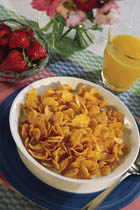
Anyone who believes that one dietary fiber fits all applications has not experienced the sensory disharmony of a soggy cereal breaking apart in milk. Such is an example of a high-absorbent fiber used in a dry application.
The Vitacel[r] line of food-grade fibers from J. Rettenmaier USA (Schoolcraft, Mich.) uses a new manufacturing process that takes advantage of bleaching and extraction technology. “Parts of the products are extracted, parts are not. The unique extraction process helps our yield, gives a cost benefit and also provides us latitude in the types of products we can produce,” says Jon Bodner, senior manager for applications and market development at the company. “In the process of extracting the oat fiber, we can alter the structure for better functionality.”
The process creates a wide range of ingredients--from low-absorbing to high water-binding types of fiber particles. For example, manufacturers of low-carb bakery products need to replace flour in the formulation. A fiber with a low water-binding capacity would work, since flour has very low water absorbency. There are crackers, cookies, ice cream cones and many other low-moisture applications where significant water binding could damage product integrity.
Too much water causes structural problems and changes organoleptic properties. “Products can become bland because the flavor components are diluted with water,” explains Bodner. Excess water also decreases strength in baked products by preventing dough from rising as much.
Longer-strand fibers generally hold more water and reinforce a rod-type structural component. “High water-absorption fibers also impart flexibility to deter susceptibility to breakage,” describes Bodner. “We've seen longer-strand fibers used to prevent bagel chips from deteriorating, which results in fine dust at the bottom of the bag.”
The dietary fiber obtained from the oat hull is comprised of mucilage, hemicellulose, cellulose-fractions and a little bit of lignin. Chipping away from the starting raw material eventually produces pure cellulose, which has the highest absorbency. Ingredients produced from the stages before pure cellulose is reached have different characteristics for various uses. For example, in meal replacement drinks, a combination of these insoluble fibers with hydrocolloids forms synergistic effects on the product's viscosity. In meat products, Vitacel Oat fibers act as an extender. Since fat gives a lubricating mouthfeel, some products tend to feel dry and a bit rubbery when fat is removed. Fibers can minimize that effect and make the texture soft again.
Aside from oats, the other fibers start with different substrates and are more mechanical in nature. Vitacel Bamboo fiber has a very smooth texture, appropriate in beverages because it helps minimize the coarser, rougher mouthfeel that insoluble fibers and cellulose-type fibers have.
Vitacel Cottonseed fiber has medium to low water absorption, with a very white color, and is a viable alternative in a high-fiber, white bread. Vitacel Wheat fiber has higher absorption capabilities and also is fairly white, though not as white as the cottonseed. In nutrition bars, Vitacel apple and orange fibers are used as a fiber source, for flavor and also are gluten- and phytic acid-free.
For more information:
J. Rettenmaier USA, Jon Bodner
269-679-2340, jbodner@jrsusa.com, www.jrsusa.com